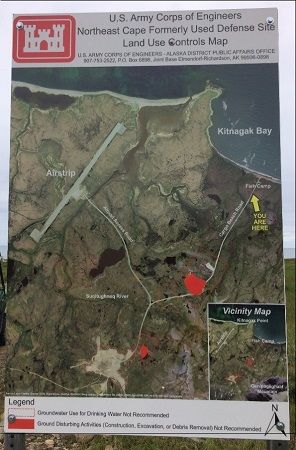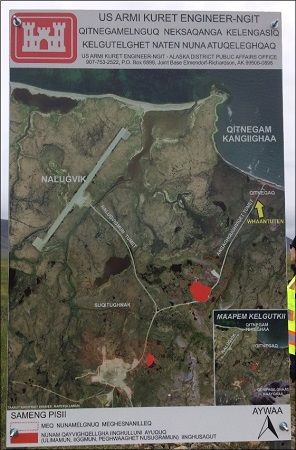Northeast Cape and Gambell Formerly Used Defense Sites
- View detailed information from the database on this site.
- Database Name: St Law NEC Facility Wide
- Status: Active
- Location: Savoonga
- Latitude: 63.310250
- Longitude: -168.964278
- DEC Contaminated Sites contact: Erica Blake, Project Manager, 907-451-2182
- U.S. Army Corps of Engineers (USACE) contact: Jeremy Craner, Project Manager, 907-753-2628
Also see related site: St Law Gambell Facility Wide. USACE established and maintained active Restoration Advisory Boards (RAB) during the remedial investigation and cleanup efforts for both the Gambell and Northeast Cape FUDS. USACE continues to conduct public meetings with the communities in conjunction with ongoing CERCLA Five-year and Periodic Reviews as well as long-term monitoring efforts at Northeast Cape.
- Click on photos or maps for larger versions.
- Contacts updated: 2/16/2023
- Summary updated: 2/16/2023
Site Narrative
Description
Two Formerly Used Defense Sites (FUDS) are located on St. Lawrence Island. The U.S. military stationed forces in and around Gambell during and after World War II. The Air Force operated an Aircraft Control and Warning Station in Gambell from 1948 to 1956. The site was abandoned after a similar facility was constructed at Northeast Cape on the island. The landowners are the Sivuqaq Native Corporation (for Gambell) and the Savoonga Native Corporation. The U.S. Army Corps of Engineers is responsible for cleanup at the sites through its FUDS program.
Northeast Cape
The Northeast Cape FUDS is located about 60 aerial miles from Savoonga, the nearest village. The Northeast Cape FUDS was constructed as an Aircraft Control and Warning Station (AC&WS) during 1950 and 1951 to provide radar coverage and surveillance for the Alaskan Air Command, and later for the North American Air Defense Command, as part of the Alaska Early Warning System. The site was activated in 1952 and a White Alice Communications System (WACS) station was added to the site in 1954. The AC&WS and WACS operations were terminated in 1969 and 1972, and personnel subsequently removed from the site.
The Northeast Cape FUDS included areas for housing site personnel, power plant facilities, fuel storage tanks, distribution lines, maintenance shops, wastewater treatment facilities, and landfills. The buildings and majority of furnishings and equipment related to the AC&WS were abandoned in place initially due to the high cost of off-island transport. Demolition of the buildings and other structures was completed between 1994 and 2003. All the buildings, above ground structures and debris have been removed from Northeast Cape and disposed of off island. The runway, improved gravel roads, and concrete slabs of some of the former structures remain intact.
The main sources of contamination are attributed to spills and leaks of fuel products associated with aboveground storage tanks (ASTs), underground storage tanks (USTs), and associated piping. Other sources of contamination include electrical transformers, waste stored in 55-gallon drums, metal debris, and organic chemicals from paint, solvents, and other miscellaneous facility activities. Initial response actions were conducted at some of the Northeast Cape sites prior to decision document preparation and signature approval.

Figure A-2 from the U.S. Army Corp of Engineers Alaska District, Second Periodic Review Report for Multiple Sites, Northeast Cape FUDS, St. Lawrence Island, Alaska (report dated 2019).
Between 1994 and 2004, four remedial investigations were conducted at the Northeast Cape FUDS. Environmental concerns were grouped into 34 sites (see Figure A-2). Following the feasibility study in 2007, two Decision Documents (DD’s) were signed September 2009; the multi-site Decision Document: Hazardous, Toxic, and Radioactive Waste (HTRW) Project #F10AK096903, Northeast Cape FUDS, St. Lawrence Island, Alaska and the Decision Document: Site 7 Cargo Beach Road Landfill Containerized Hazardous, Toxic, and Radioactive Waste (CON-HTRW) Project #F10AK096905 Northeast Cape FUDS St. Lawrence Island, Alaska. A range of alternatives was considered for each of the 34 individual sites, including no further action, LUCs, natural attenuation, long-term monitoring, phytoremediation, landfarming, thermal treatment, in situ chemical oxidation (ISCO), reactive walls, reactive matting, constructed wetlands, and excavation and offsite disposal.
Numerous technical challenges were identified regarding the impracticality and infeasibility of physical removal of contamination in many locations and as a result, the selected remedies in the 2009 Decision Document were based upon determinations that physical removal actions at these areas would result in greater damage to the environment and natural resources of the drainage and ecosystem areas while also increasing the mobility and exposure risk associated with the contamination. Large extents of polychlorinated biphenyls (PCBs) in soil were removed from several locations across Northeast Cape and the most stringent cleanup level for PCBs in soil (1 milligram per kilogram) was achieved at all PCB sites. Contaminated sediment in the river drainage basin (referred to as Site 28), was removed via dredging and disposed offsite in conjunction with the 2013 and 2014 removal action efforts.
As of the end of 2018, approximately $125 million had been authorized and spent by the Department of Defense on contamination cleanup and remediation work at the Northeast Cape FUDS, including the prior demolition and offsite disposal of structures and debris. USACE conducted the first CERCLA Five-Year Review in 2015 and developed and implemented the first long-term maintenance and management Plan in 2016. In the years since the last removal actions were conducted in 2014, USACE completed in 2019 a multi-site periodic review and a second periodic review for the Site 7 Cargo Beach, and continued with remedy implementation activities including, long-term monitoring efforts and supplemental data gap investigations.
Gambell
The military established the Gambell site in the 1950’s as part of a surveillance and intelligence gathering network. Various units of the United States (U.S.) Army (the Army) and U.S. Air Force (USAF) utilized the area. The USAF built a base camp in 1950 at the foot of Sevuokuk Mountain and a radar site directly above on the mountain top (both of these areas were abandoned in 1956). The Army occupied several sites during the late 1950’s with a main base camp located north of Troutman Lake. The Navy also laid communication cables from the village of Gambell, up Sevuokuk Mountain, and south to Brunnell Cape.
Environmental investigations and cleanup activities at Gambell began in the 1980’s. The first remedial investigation was conducted in 1994. The Gambell sites were subdivided into 38 separate areas. The majority of contamination was petroleum-impacted soil. There were areas with low concentrations of dioxins (below cleanup standards) and reported unexploded ordnance (UXO) in Troutman Lake. Construction debris, military equipment and small quantities of hazardous substances were removed through the Native American Lands Environmental Mitigation Program (NALEMP) because USACE did not consider buried debris FUDS eligible. Additional areas with buried material were reported to exist around the village. The Native Village of Gambell subsequently received several grants from NALEMP to fund debris cleanup at Gambell between 2003 and 2008. The Gambell NALEMP project was the largest in the nation, with 290,000 pounds of buried debris removed in 2006. An investigation of the groundwater near the village water supply (Site 5) detected a low-level concentration of diesel range organics (DRO) in one monitoring well in 1998. Subsequent sampling did not find DRO in the well, and testing of the water supply well showed no detectable contamination.
The investigation and cleanup at Gambell cost $7 million. As the investigation and remedial work progressed, new areas of contamination were reported or discovered, lengthening the process. USACE issued a Record of Decision for Gambell in 2007 at which time DEC issued approvals for the closure of all 38 sites. For all the sites that had hazardous and toxic waste in containers, those containers were taken to hazardous waste treatment facilities off the island. The cleanup of the Gambell FUDS sites was completed in 2007 and 2008, when all the associated contaminated sites were determined to be cleanup complete.
Public Health and Environmental Concerns
The communities and residents of Gambell and Savoonga have had concerns and have been active and involved throughout the FUDS cleanup process. Both communities and respective RABs received FUDS funded grants for Technical Assistance for Public Participation (TAPP); between 2001-2008 for Gambell and between 2008-2014 for Northeast Cape. TAPP grants provide financial resources for communities to hire technical support to assist them with the technical aspects of the process and to help review and develop comments on the many associated documents.
The areas surrounding the Northeast Cape FUDS are used seasonally by Saint Lawrence Island residents for subsistence hunting and gathering. The community has expressed concern over cancer rates and a possible link to former military sites at Northeast Cape. There has also been concern over possible impacts to subsistence foods, such as reindeer and fish, from the area.
The Army Corps of Engineers began a risk assessment in 2001 to gather the missing data and discover any risks involved. Assessing risk involves considering many details such as the type of food consumed, how often it’s consumed, the contaminant levels, and the health sensitivities of the people who consume the food. DEC and USACE worked extensively with the community during the three years it took to complete the risk assessment, during which the risk assessment surveys determined that island residents do not eat fish from Suqitughneq River. Residents do, however, fish along another stream that is located within the drainage. Dolly Varden fish tissue samples were collected from the Suqitughneq River drainage in 2001 and the analysis results indicated that the fish tissues contained PCBs at concentrations slightly above the ingestion levels recommended by the Environmental Protection Agency. The risk assessment concluded that since the Dolly Varden fish are migratory species and do not stay in the stream their whole lifetime, that the fish pick up contaminants from other sources in addition to the Suqitughneq River drainage, primarily the marine habitat.
Representatives from the Agency for Toxic Substance and Disease Registry visited both communities and conducted two separate health consultations in 1999 and 2013. ATSDR’s first consultation report, released in September 2000, concluded there was low risk from consumption of reindeer. It noted concerns, however, about fish consumed from the Suqitughneq River which flows adjacent to and downgradient of the Northeast Cape FUDS and is the receiving surface water body for the nearby and upgradient drainages. ATSDR further recommended residents avoid eating fish from the drainage until a more comprehensive remedial investigation and cleanup effort was completed; noting further that resident fish are not currently used from the Suqitughneq River as they are too small for subsistence use. The reports associated with ATSDR’s second health consultations for both Gambell and Savoonga were released in 2017. ATSDR concluded in both consultation reports that contamination associated with either the Gambell and/or the Northeast Cape FUDS did not represent unacceptable exposure risk(s) to the residents of Saint Lawrence Island.
Current Status
Cleanup of the at Gambell FUDS was completed in 2007 and 2008, and the associated contaminated sites were determined to be cleanup complete.
USACE conducted remedial investigation and removal activities at Northeast Cape during the years of 2008-2014. USACE established and maintained active Restoration Advisory Boards (RABs) during the investigation and cleanup efforts for both the Gambell and Northeast Cape FUDS. Although the removal actions and primary remedial objectives are completed at both the Gambell and Northeast Cape FUDS, USACE continues to conduct public meetings with the communities in conjunction with ongoing CERCLA Five-Year and Periodic Reviews as well as long-term monitoring efforts at Northeast Cape. DEC continues to work with the community and USACE on the oversight and implementation of the ongoing long-term management of Northeast Cape.
The most recent fieldwork was conducted in 2022 at Northeast Cape. Site work occurred at Site 7, Site 8, Site 28, Site 15, the Main Operations Complex (MOC) and the gravel airstrip and gravel road.



